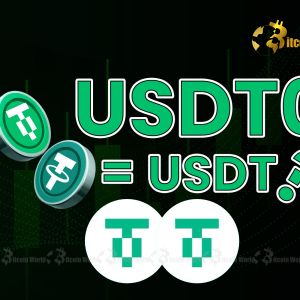USDT0’s Breakthrough: Revolutionizing Bitcoin L2 Through Rootstock Integration
6 min read
BitcoinWorld USDT0’s Breakthrough: Revolutionizing Bitcoin L2 Through Rootstock Integration In the rapidly evolving world of decentralized finance, one constant challenge has been bridging the gap between disparate blockchain ecosystems. Stablecoins, the digital assets pegged to fiat currencies, play a crucial role in providing stability and liquidity across these networks. Now, a significant development is set to transform the landscape of Bitcoin-centric finance: the cross-chain version of the USDT stablecoin, known as USDT0 , has officially integrated with Bitcoin L2 Rootstock. This isn’t just another technical update; it’s a pivotal moment that promises to unlock unprecedented utility and interoperability within the burgeoning BTCFi ecosystem. What Does This USDT0 Integration Mean for Bitcoin DeFi? The integration of USDT0 with Rootstock is a game-changer for several reasons. Previously, stablecoin usage on the Bitcoin network was limited, primarily due to Bitcoin’s native design, which prioritizes security and decentralization over smart contract functionality. Layer-2 solutions like Rootstock address this by adding a smart contract layer on top of Bitcoin, allowing for more complex applications, including DeFi protocols. By bringing USDT0 onto Rootstock, users gain a robust, liquid, and widely accepted stablecoin directly connected to the security of the Bitcoin blockchain. This move significantly enhances the capabilities of the BTCFi space, which aims to bring DeFi applications and services directly to Bitcoin holders. Imagine being able to lend, borrow, or provide liquidity using a stablecoin that is anchored to Bitcoin’s security. This integration makes that vision a reality, paving the way for a more vibrant and versatile financial ecosystem built around the world’s largest cryptocurrency. Understanding Rootstock: Bitcoin’s Smart Contract Powerhouse To fully appreciate the impact of this Stablecoin Integration , it’s essential to understand what Rootstock brings to the table. Rootstock (RSK) is a smart contract platform that is secured by the Bitcoin network through a process called merged mining. This means that Bitcoin miners can simultaneously mine Rootstock blocks without expending additional hash power, effectively extending Bitcoin’s security to Rootstock’s smart contracts. Here’s why Rootstock is crucial for Bitcoin’s DeFi ambitions: Bitcoin Security: Rootstock inherits the unparalleled security of the Bitcoin blockchain, making it a highly secure environment for DeFi applications. EVM Compatibility: Rootstock is Ethereum Virtual Machine (EVM) compatible, meaning developers can easily port existing Ethereum dApps and smart contracts to Rootstock with minimal changes. This dramatically lowers the barrier to entry for developers looking to build on Bitcoin. Scalability: As a Bitcoin L2 , Rootstock offers significantly higher transaction throughput compared to Bitcoin’s mainnet, making it suitable for DeFi operations that require faster and cheaper transactions. Decentralization: Rootstock maintains a high degree of decentralization, aligning with the core principles of Bitcoin and open finance. The ability of Rootstock to leverage Bitcoin’s robust security while providing a flexible smart contract environment makes it an ideal home for a major stablecoin like USDT0. Expanding Reach: USDT0’s Cross-Chain Dominance and What it Means for Stablecoin Integration USDT0 isn’t just any stablecoin; it’s a cross-chain iteration of Tether’s USDT, designed for seamless movement across multiple blockchain networks. Before this latest development, USDT0 had already established a significant presence across: Ethereum: The leading smart contract platform, home to a vast DeFi ecosystem. Arbitrum: A popular Ethereum Layer-2 scaling solution, known for its efficiency. Optimism (OP Superchain): Another prominent Ethereum Layer-2, part of the growing OP Superchain network. Unichain: A lesser-known but active blockchain, demonstrating USDT0’s commitment to broad interoperability. This extensive multi-chain presence underscores USDT0’s commitment to liquidity and accessibility. The addition of Rootstock to this list is not merely an expansion; it’s a strategic move that brings the liquidity and widespread acceptance of USDT directly into the Bitcoin ecosystem. This Stablecoin Integration on a Bitcoin L2 opens up new avenues for capital efficiency and removes significant friction for users who want to utilize stable assets within BTCFi. The Rise of BTCFi: How Stablecoins Supercharge Bitcoin’s DeFi Future For years, Bitcoin has been seen primarily as a store of value. While its unparalleled security and decentralization are undeniable, its limited programmability has kept it somewhat separate from the explosion of DeFi innovation seen on platforms like Ethereum. However, with the advent of sophisticated Bitcoin L2 solutions like Rootstock, the narrative is rapidly changing. The concept of BTCFi is gaining serious momentum, aiming to unlock Bitcoin’s dormant capital for DeFi applications. The integration of a major stablecoin like USDT0 is a crucial catalyst for BTCFi’s growth. Here’s why: Enhanced Liquidity: Stablecoins provide a stable base for trading pairs, lending pools, and other financial instruments, attracting more capital into the BTCFi ecosystem. Reduced Volatility: Users can participate in DeFi activities without constant exposure to Bitcoin’s price volatility, making it more appealing for traditional finance participants and risk-averse users. New Use Cases: With stablecoins, Rootstock can host a wider array of financial services, including: Decentralized Exchanges (DEXs) with stablecoin trading pairs. Lending and borrowing protocols using stablecoins as collateral or borrowed assets. Yield farming opportunities for stablecoin holders. Payment solutions leveraging the speed and low cost of Rootstock transactions. Broader Adoption: The familiarity and utility of USDT0 can attract a wider user base, including those who are new to DeFi or prefer stable assets. This development solidifies Rootstock’s position as a key player in the Bitcoin L2 landscape and a vital bridge for stablecoin liquidity into BTCFi. Challenges and Opportunities in the Evolving Bitcoin L2 Landscape While the USDT0 integration with Rootstock is a monumental step forward for BTCFi , it’s important to acknowledge the broader challenges and opportunities within the Bitcoin Layer-2 space. The ecosystem is still nascent compared to Ethereum’s DeFi landscape, and competition among various L2 solutions is growing. Challenges include: User Adoption: Educating users about the benefits and mechanics of Bitcoin L2s and encouraging them to migrate assets. Developer Ecosystem: Attracting more developers to build innovative applications on Rootstock and other Bitcoin L2s. Interoperability with Other Bitcoin L2s: Ensuring seamless asset transfer and communication between different Bitcoin scaling solutions as they emerge. Regulatory Clarity: Navigating the evolving global regulatory landscape for stablecoins and DeFi. However, the opportunities far outweigh the challenges. The sheer size and security of the Bitcoin network represent an enormous untapped potential for DeFi. With strategic Stablecoin Integration like USDT0 on Rootstock, the path is clear for Bitcoin to become a powerhouse not just as a store of value, but as a foundation for a robust, decentralized financial system. What’s Next for USDT0 and BTCFi? Actionable Insights This integration marks a new chapter for both USDT0 and the broader BTCFi movement. For users, it means new avenues for utilizing their stablecoin holdings directly within the Bitcoin ecosystem, without needing to bridge to other non-Bitcoin-secured chains. For developers, it signals a growing demand for DeFi applications on Bitcoin L2 solutions, particularly those that can leverage stablecoin liquidity. Here are some actionable insights: For Stablecoin Holders: Explore DeFi protocols on Rootstock that now accept USDT0. Look for opportunities in lending, borrowing, or providing liquidity to earn yield. For Bitcoin Enthusiasts: This is an excellent time to delve deeper into the capabilities of Rootstock and other Bitcoin L2s. Understand how these technologies are expanding Bitcoin’s utility beyond just being digital gold. For Developers: Consider building dApps on Rootstock. The EVM compatibility combined with the new stablecoin liquidity makes it an attractive environment for innovation in the BTCFi space. For Ecosystem Participants: Keep an eye on further Stablecoin Integration announcements and infrastructure developments within the Bitcoin Layer-2 ecosystem. The landscape is evolving rapidly. The synergy between a leading stablecoin and a secure, EVM-compatible Bitcoin Layer-2 creates a powerful foundation for the future of decentralized finance on Bitcoin. Conclusion: A New Era for Bitcoin and Stablecoins The integration of USDT0 with Rootstock is far more than a technical update; it’s a strategic alignment that fundamentally enhances the utility of Bitcoin. By bringing a widely used stablecoin directly onto a secure Bitcoin L2 , this development significantly bolsters the nascent BTCFi ecosystem. It promises greater liquidity, expanded use cases, and improved interoperability, paving the way for Bitcoin to become a more active and versatile player in the global DeFi landscape. This Stablecoin Integration is a clear signal that the future of finance is increasingly cross-chain, and Bitcoin is ready to claim its rightful place at the heart of this revolution. The journey has just begun, and the potential is immense. To learn more about the latest crypto market trends and significant integrations, explore our article on key developments shaping Bitcoin’s institutional adoption and future price action. This post USDT0’s Breakthrough: Revolutionizing Bitcoin L2 Through Rootstock Integration first appeared on BitcoinWorld and is written by Editorial Team

Source: Bitcoin World



